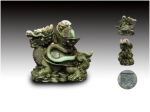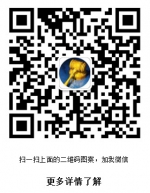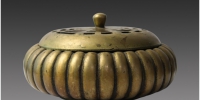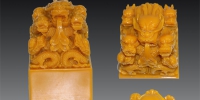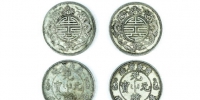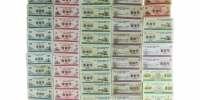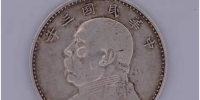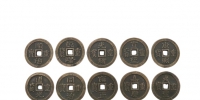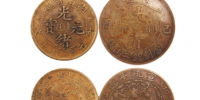2019年新加坡精品拍卖清乾隆和田青玉招财进宝摆件推荐
成都博古轩拍卖有限公司【藏.荐】栏 为藏品强大的传播效应向各位买家推荐经国家一级鉴定专家甄选的艺术珍品,为藏家牵线搭桥,让千百件艺术珍品价值被发掘与重视,在拍卖会上得以高价成交。
Chengdu Boguxuan Auction Co., Ltd. [Tibet. Recommendation] column recommends art treasures selected by experts at the first level of national appraisal to buyers for the powerful dissemination effect of the collection. It helps collectors to bridge the gap, so that the value of thousands of art treasures can be excavated and valued, and high prices can be concluded at the auction.
【名称】:清乾隆和田青玉霸下招财进宝摆件
【规格】: 长:21.1cm宽:3.7cm 高:22.5cm
[Name]: Three years of Yuan Datou Republic (Signed Edition)
[Specification]: Weight: 26.6g thickness: 2.5mm [Name]: Qianlong Qing Dynasty and Tian Qingyuba recruit wealth and treasure items
[Specification] Long: 21.1 cm wide: 3.7 cm high: 22.5 cm
[Name]: Three years of Yuan Datou Republic (Signed Edition)
[Specification] Weight: 26.6g Thickness: 2.5mm
霸下,又名赑屃、龟趺、填下、龙龟等,是中国古代传说中的神兽,为鳞虫之长瑞兽龙之九子第六子,样子似龟,喜欢负重,碑下龟是也。霸下是长寿和吉祥的象征。它总是奋力地向前昂着头,四只脚顽强地撑着,努力地向前走,并且总是不停步。
霸下的形象其原形可能为斑鳖,霸下和龟十分相似,但细看却有差异,霸下有一排牙齿,而龟类却没有,霸下和龟类在背甲上甲片的数目和形状也有差异。
青玉是和田玉四大类别之一,主要分布在新疆塔里木盆地之南的昆仑山脉,是和田玉中数量最大的组成部分,其物质成分跟白玉相近,其中,有一部分细腻的青玉韧性也更好。青玉由淡青色到深青色,颜色的种类很多,古籍记载有蚺子青、鼻涕青、蟹壳青、叶青等等。现代以颜色深浅不同,也有淡青、深青、碧青、灰青、深灰青等等之分。和阗玉中青玉最多,常见大块者。近年,见有一种翠青玉,呈淡绿色。和田青玉是和田玉中数量最大的组成部分,其物质成分跟白玉相同或相近,成因与白玉一样,都属于接触变质成因形成,只因含微量元素铁而呈现出差异。
和田青玉在和田玉中是硬度最高的,玉质细腻温润、玉色深重且纯正一致,整体呈现刚劲之气,寓意着基业长青,所以从古至今一直都是国玺的主要选材,历代封建王朝的传国玉玺均为青玉材质,代表清王朝最高皇权的清二十五方宝玺中,有13枚都是青玉玉玺,所以玉器专家都称和田青玉为“帝王之玉”。
2005年至2012年,和田青玉的收购价就以每年40%的幅度不断上涨,09年底猛涨的石头有所缓和,但一过春节,价格立马一路飙升至今,2012年上半年,一块好的玉料,价格至少比过去翻了两倍。
中国玉雕大师、中国工艺美术大师顾峰分析和田青玉价格近几年猛涨的原因,一是由于和田青玉的价格历来都被严重低估,第二是中国经济快速增长带来了文化的繁荣,国民“君子爱玉”的情节被激发,收藏和田玉的人群不断增长,促使和田青玉的价格呈现“爆炸式”增长。
此霸下和田青玉招财进宝摆件是大清乾隆年制,雕工精美,线条流畅,布局合理,寓意很好,可遇不可求,值得收藏。
Under the hegemony, also known as Chao Lai, Turtle Bo, filling, Dragon Tortoise and so on, is the god beast in ancient Chinese legend. It is the sixth son of the ninth son of Ruiwu Dragon, the head of the scalworm. It looks like a turtle and likes to bear heavy loads. The turtle under the stele is also. Hegemony is the symbol of longevity and auspiciousness. It always struggles to move forward with its head held high, its four feet stubbornly supported, and strives to move forward, and always does not stop.
The original shape of the image under the hegemony may be zebra turtle, which is very similar to the tortoise, but there are differences on closer inspection. There is a row of teeth under the hegemony, but the tortoise does not. The number and shape of the nails on the back of the hegemony and the tortoise are also different.
Qingyu is one of the four categories of Hetian Jade. It mainly distributes in the Kunlun Mountains in the south of Tarim Basin, Xinjiang. It is the largest component of Hetian Jade. Its material composition is similar to that of Baiyu. Among them, some exquisite Qingyu has better toughness. Qingyu is from light blue to dark blue. There are many kinds of colors. Ancient books record the green of worms, runny nose, crab shell, leaf and so on. Modern with different shades of color, there are also light green, dark green, blue, grey green, dark grey green and so on. Among Hetian jade, sapphire is the most common. In recent years, there is a kind of emerald jade, which is pale green. Hetian Qingyu is the largest component of Hetian Jade. Its material composition is the same or similar to that of Baiyu, and its genesis is the same as that of Baiyu. It belongs to contact metamorphism. It is different only because of the trace element iron.
Hetian Qingyu has the highest hardness in Hetian Jade. The quality of the jade is delicate and moist, the color of the jade is deep and pure. It shows the vigor of the whole and implies the evergreen foundation. So it has been the main selection of the national seals from ancient times to present. The jade seals of successive feudal dynasties are all made of green jade, representing the Qing Dynasty's highest imperial power. Among the five precious seals, 13 are green jade seals, so jade experts call Hetian Qingyu "the jade of emperors".
From 2005 to 2012, the purchase price of Hetian Qingyu has been rising by 40% annually, and the rocks that soared at the end of 2009 have eased. But after the Spring Festival, prices have soared all the way up to now. In the first half of 2012, the price of a good piece of jade has at least doubled compared with the past.
Gu Feng, a master of Chinese jade carving and arts and crafts, has analyzed the reasons why Tian Qingyu's price has soared in recent years. First, the price of Hetian Qingyu has always been seriously underestimated. Second, China's rapid economic growth has brought about cultural prosperity. The plot of "gentleman loves jade" has been stimulated, and the people who collect and collect Hetian Qingyu have continued. Growth has led to an explosive increase in the price of Hetian Qingyu.
Hetian Qingyu's treasure collection is the Qianlong year of the Qing Dynasty, with exquisite sculpture, smooth lines, reasonable layout, good implication, and is worth collecting.
